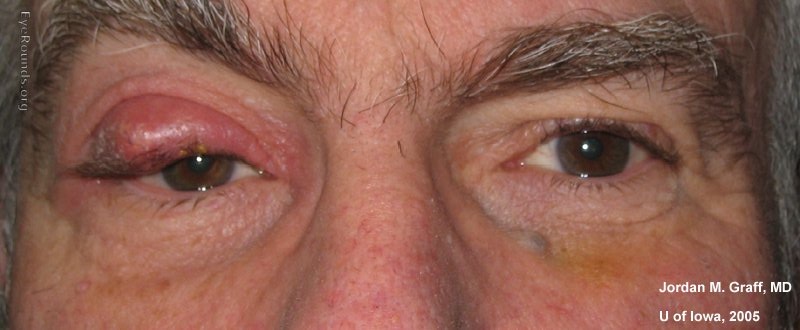Chalazion
All content on Eyewiki is protected by copyright law and the Terms of Service. This content may not be reproduced, copied, or put into any artificial intelligence program, including large language and generative AI models, without permission from the Academy.
Chalazion is a common condition usually presenting as eyelid swelling or painless nodule over eyelid. It affects upper eyelid more commonly than lower lid because there are more meibomian glands in the upper lid. This condition affects both sex equally and occurs in all age group.
Want a brief, patient-friendly summary of chalazion? Visit geteyeSmart.org
Disease Entity
Chalazion is a subcutaneous nodule in the upper or lower eyelid.
Disease
Chalazion is a chronic sterile granuloma residing within eyelid that originates from an obstructed meibomian gland of the tarsal plates. If acute secondary infection (e.g. Staphylococcus aureus) takes place, the lesion is known as hordeolum.
Etiology
Chronic granulomatous reaction in the eyelid induced by retained sebaceous secretions from meibomian gland.
Risk Factors
History or blepharitis, rosacea, prior chalazion, or any type of eyelid inflammation. Other factors can be uncorrected refractive errors and uncontrolled diabetes, long hours of work on computers.
General Pathology
Histology of the lesion will reveal cells characterizing chronic granulomatous inflammation, namely multinucleated giant cells and epithelioid cells (lipid-laden macrophages in this case). Lymphocytes and plasma cells may also be present.
Pathophysiology
Meibomian glands are sebaceous glands located in the tarsal plate of eyelid. Their secretion includes polar and non-polar lipids, which are components of tear film. If the outflow of these sebaceous secretions is obstructed, the oily secretions are retained and may leak into the adjacent tissue, which will in turn induce chronic granulomatous inflammatory response leading to formation of lipogranuloma.
Primary prevention
Regular massage and warm compresses can help in drainage of the sebaceous secretion and therefore decrease occurrence or recurrence of chalazion. Maintaining good lid hygiene may also be beneficial.
Diagnosis
Diagnosis is by clinical findings. Further workup for confirmation is usually not necessary except in recurrent cases where sebaceous gland carcinoma needed to be excluded.
History
Patient usually presents with gradually enlarging eyelid nodule, eyelid discomfort or even painful swelling if secondary infection occurs. Many patients would have history of similar eyelid swelling in the past
Physical examination
On examination of the eyelid, a solitary, non-tender nodule should be noted in the tarsal plate. Eversion of eyelid may help identifying the lesion if it is not apparent over skin surface.
Clinical diagnosis
Clinical diagnosis is usually based on patient's history and appearance of the lesion.
Diagnostic procedures
Slit-lamp examination to assess the condition of the meibomian glands (which often show diffuse inspissation of yellowish contents from the eyelid margin orifices). The eyelid should be everted to exclude other pathologies, such as a retained foreign body, or tarsal cyst.
Laboratory test
Usually not necessary. Microscopy of the materials from chalazion shows chronic inflammatory cells and occasionally acute inflammatory cells such as polymorphs.
Differential diagnosis
Malignant or benign tumours such as sebaceous gland tumour; Inflammatory conditions including cellulitis, dermatitis; Insect bite; tarsal cyst
Management
Small, asymptomatic chalazion can be left untreated. Conservative treatment including lid massage, warm compression and steroid eyedrops can also be used. Topical antibiotics eyedrops is useful if lesion is associated with inflammatory conditions such as blepharitis; Direct injection of steroid with lignocaine into the lesion may be preferable for lesions in close proximity to the vulnerable lacrimal apparatus where surgical drainage is difficult. Steroid injection leads to resolution in most cases; repeated injection can be given 1-2 weeks later if lesion persists.
Medical therapy
Prophylactic systemic tetracyclines (such as doxycycline) can be considered in recurrent cases. There may be a role for topical antibiotics prophylaxis with macrolide antibiotics (such as erythromycin ointment or Azithromycin gel).
Surgery
Surgical treatment may be considered in case of unresolved chalazion or large and symptomatic chalazion. Incision and curettage is the treatment of choice.
Local anaethestic agent is injected to the area surrounding the lesion. Eyelid is then everted with special clamp and incision is made through conjunctiva. Contents of chalazion are curetted, and tarsus may be minimally resected if indicated. Since the operation is done at the inner side of eyelid, no scar will be seen over the anterior aspect of the lid.
Surgical follow up
Patient may be seen again in several weeks, or follow-up as required. The inflamed lid may still take several weeks to completely resolve.
Complications
Large chalazion can occasionally exert mass effect on cornea and result in astigmatism and blurred vision; Acute secondary infection leading to pain that may require incision and curettage.
Transconjunctival steroid injection may lead to local skin depigmentation or atrophy of skin.
Prognosis
Excellent prognosis could be expected. Untreated chalazion usually resolves spontaneously in weeks. However, recurrence is common.
Additional Resources
American Academy of Ophthalmology Preferred Practice Patterns (AAO)
Want a brief, patient-friendly summary of chalazion? Check out geteyeSmart.org


